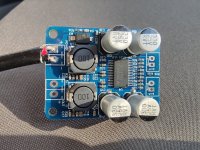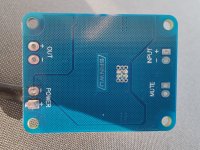Yes I know what the regulator is for. It's interesting that you consider it "not important". I've been hearing conflicting claims for the last 3 years. Here's what abraxalito said:
The disparity of opinions is stark.
And JLesterP's SYLPH-D200 TPA3255 board uses a TPS7A49 for GVDD/VDD, instead of the typical LM2940.I've been listening a while and figure the next 'bottleneck' is most likely the switching reg powering the VDDA rail. Its a LM5010 set to 5V, I figure if I set it to say 7V with a resistor tweak I can put a linear reg between it and the TPA3220.
The disparity of opinions is stark.
Any idea what these chips actually are? It's a 28-pin SSOP package, and can handle a 21V rail just fine. They sound terrible but I guess that's expected for a fake, remarked chip. These are sold on Amazon (India) for just under $5 each. Interestingly the listing shows the correct PCBs, but this what you get in the package.
I want to reduce gain and/or try PFFB to improve things, as someone who's using a remarked $2 chip will be using inductors below the bottom of the barrell. I soldered the headers and thus can't legitimately ask for a return, but I wasn't expecting fakes so I didn't pay much attention.
I want to reduce gain and/or try PFFB to improve things, as someone who's using a remarked $2 chip will be using inductors below the bottom of the barrell. I soldered the headers and thus can't legitimately ask for a return, but I wasn't expecting fakes so I didn't pay much attention.
Attachments
So you think anyone is bothering to fake a $1 chip that is outdated already? They are saving on everything else that makes this chip sound good...
Edit: nevermind, I didn't count the pins. Strange, indeed...
Edit: nevermind, I didn't count the pins. Strange, indeed...
Any idea what these chips actually are? It's a 28-pin SSOP package, and can handle a 21V rail just fine. They sound terrible but I guess that's expected for a fake, remarked chip. These are sold on Amazon (India) for just under $5 each. Interestingly the listing shows the correct PCBs, but this what you get in the package.
I want to reduce gain and/or try PFFB to improve things, as someone who's using a remarked $2 chip will be using inductors below the bottom of the barrell. I soldered the headers and thus can't legitimately ask for a return, but I wasn't expecting fakes so I didn't pay much attention.
Those are TPA3110 chips (or some Asian equivalent).
I had the same issues. Check couple of page back in this topic.
There is a little error in the board, just connect pin 5 and 6 to ground and your board will be nice and quiet! 🙂
(ground should be on pin 3 and 4 if I am not mistaken, but pls double check)
use 8 ohm speakers, on 4 ohms some sort off protection circuit or output choke limitation causes audio at high volume to cut out. I got those from aliexpress in 2019
Can anyone recommend a seller of genuine TPA3118 boards? I've got 6 from two different sellers (one ebay, one aliexpress); all fake, as per b_force's description a few posts back . The ebay seller has previously sold me genuine ones too.
Hi all. I hope you are keeping safe and well and enjoying the run up to the holidays 🙂
I started reading through this thread but it’s reasonably substantial 😛 I’ll apologise to start, because I expect this has been asked and answered at various points in the thread but
I have a Sinilink SY-X100H:
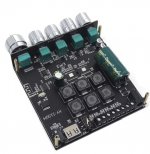
And XH-M567 (actual TPA chip, not the knock off thinner chip):
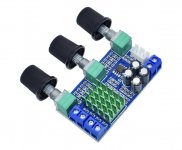
Which have the expected pop noise on power on/off.
What is the current widely accepted fix for this? I’ve looked through a lot of different suggestions and this one by @DUG:
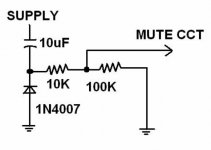
Seems to be the only one that says it cures the pop when powering off. Is this the go to?
I started reading through this thread but it’s reasonably substantial 😛 I’ll apologise to start, because I expect this has been asked and answered at various points in the thread but
I have a Sinilink SY-X100H:

And XH-M567 (actual TPA chip, not the knock off thinner chip):

Which have the expected pop noise on power on/off.
What is the current widely accepted fix for this? I’ve looked through a lot of different suggestions and this one by @DUG:

Seems to be the only one that says it cures the pop when powering off. Is this the go to?
Hi! Today, for the first time, I tried my tpa3118 SANWU boards that I bought some years ago from ebay for perhaps $3 each. They seems both to be completely dead. Upon power up they pulls down the input voltage from 12V -> 2-3V. I measured the power input in it was not shorted, so perhaps there are some short/problem after the diode.
There is no sound at all from the output. No power on thump, hiss or anything. I also tried a 24V led driver that goes into protection directly on power on.
Anyone had this issue?
There is no sound at all from the output. No power on thump, hiss or anything. I also tried a 24V led driver that goes into protection directly on power on.
Anyone had this issue?
Sounds like a dead short (solder bridge or the protection diode is on backwards) on the power input pins. Never had a TPA3116 do this.
The psu:s are both DC. The diode must be correct way otherwise it should not let through any current at all. So I guess something after the diode is shorted, but I cant see anything suspicious.
I bought about 10pcs from different Aliexpress vendors for 1.25$ each, all worked perfectly. Post your 3118 photos. Maybe they are fakes
Hi everyone
Is there a neat way to mount a female jack socket on the aluminium case? I´m useing a generic Acer 19V 5.5 x 1.7mm male socke pc charger .
I found these on Aliexpress. No one seems to be 5.5mm x 1.7mm female pin.
https://www.aliexpress.com/item/1005003324016159.html?spm=a2g0o.productlist.0.0.44ba3012bTNdg2&algo_pvid=e95ac694-8e0f-4b84-8ca4-c8df04ba2236&aem_p4p_detail=202208180920584660563454897790020157995&algo_exp_id=e95ac694-8e0f-4b84-8ca4-c8df04ba2236-2&pdp_ext_f={"sku_id":"12000025352507410"}&pdp_npi=2@dis!BRL!14.92!9.71!!!29.24!!@2101e9d116608396584651962e8d31!12000025352507410!sea&curPageLogUid=q2uEANGbTUkI&ad_pvid=202208180920584660563454897790020157995_3
TIA
Is there a neat way to mount a female jack socket on the aluminium case? I´m useing a generic Acer 19V 5.5 x 1.7mm male socke pc charger .
I found these on Aliexpress. No one seems to be 5.5mm x 1.7mm female pin.
https://www.aliexpress.com/item/1005003324016159.html?spm=a2g0o.productlist.0.0.44ba3012bTNdg2&algo_pvid=e95ac694-8e0f-4b84-8ca4-c8df04ba2236&aem_p4p_detail=202208180920584660563454897790020157995&algo_exp_id=e95ac694-8e0f-4b84-8ca4-c8df04ba2236-2&pdp_ext_f={"sku_id":"12000025352507410"}&pdp_npi=2@dis!BRL!14.92!9.71!!!29.24!!@2101e9d116608396584651962e8d31!12000025352507410!sea&curPageLogUid=q2uEANGbTUkI&ad_pvid=202208180920584660563454897790020157995_3
TIA
Last edited:
- Home
- Amplifiers
- Class D
- Cheap TPA3118D2 boards, modding them and everything that comes with it
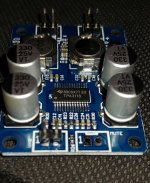
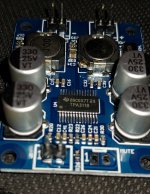
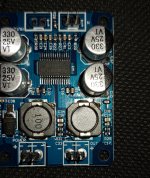



 Translation - Thank you.
Translation - Thank you.